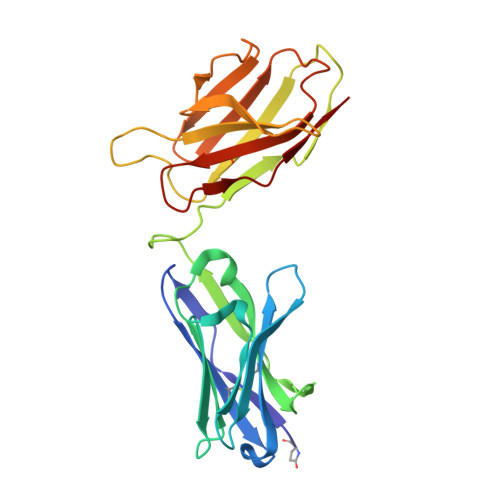CD47-blocking immunotherapies stimulate macrophage-mediated destruction of small-cell lung cancer.
Weiskopf, K., Jahchan, N.S., Schnorr, P.J., Cristea, S., Ring, A.M., Maute, R.L., Volkmer, A.K., Volkmer, J.P., Liu, J., Lim, J.S., Yang, D., Seitz, G., Nguyen, T., Wu, D., Jude, K., Guerston, H., Barkal, A., Trapani, F., George, J., Poirier, J.T., Gardner, E.E., Miles, L.A., de Stanchina, E., Lofgren, S.M., Vogel, H., Winslow, M.M., Dive, C., Thomas, R.K., Rudin, C.M., van de Rijn, M., Majeti, R., Garcia, K.C., Weissman, I.L., Sage, J.(2016) J Clin Invest 126: 2610-2620
- PubMed: 27294525
- DOI: https://doi.org/10.1172/JCI81603
- Primary Citation of Related Structures:
5IWL - PubMed Abstract:
Small-cell lung cancer (SCLC) is a highly aggressive subtype of lung cancer with limited treatment options. CD47 is a cell-surface molecule that promotes immune evasion by engaging signal-regulatory protein alpha (SIRPα), which serves as an inhibitory receptor on macrophages. Here, we found that CD47 is highly expressed on the surface of human SCLC cells; therefore, we investigated CD47-blocking immunotherapies as a potential approach for SCLC treatment. Disruption of the interaction of CD47 with SIRPα using anti-CD47 antibodies induced macrophage-mediated phagocytosis of human SCLC patient cells in culture. In a murine model, administration of CD47-blocking antibodies or targeted inactivation of the Cd47 gene markedly inhibited SCLC tumor growth. Furthermore, using comprehensive antibody arrays, we identified several possible therapeutic targets on the surface of SCLC cells. Antibodies to these targets, including CD56/neural cell adhesion molecule (NCAM), promoted phagocytosis in human SCLC cell lines that was enhanced when combined with CD47-blocking therapies. In light of recent clinical trials for CD47-blocking therapies in cancer treatment, these findings identify disruption of the CD47/SIRPα axis as a potential immunotherapeutic strategy for SCLC. This approach could enable personalized immunotherapeutic regimens in patients with SCLC and other cancers.


















